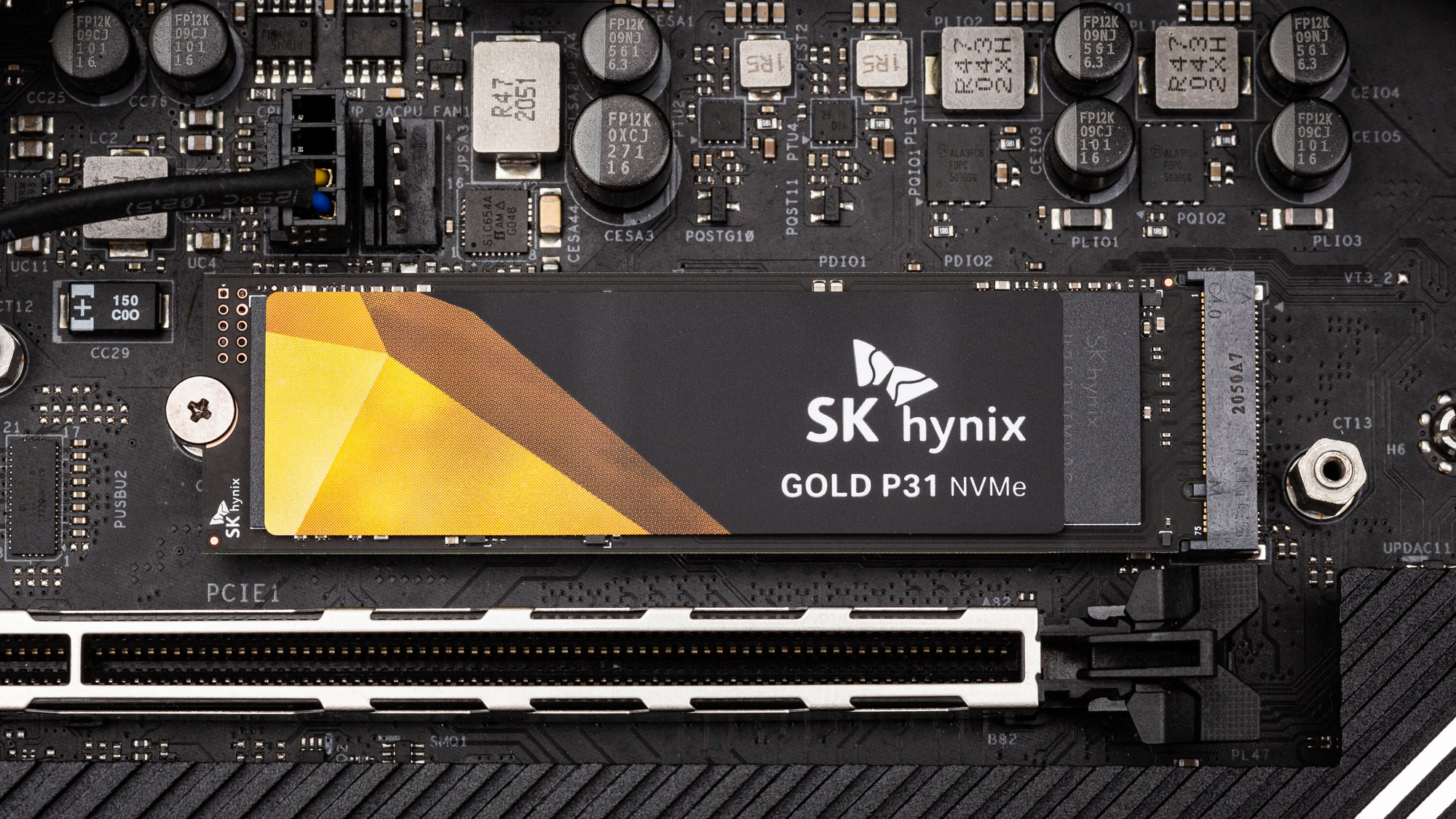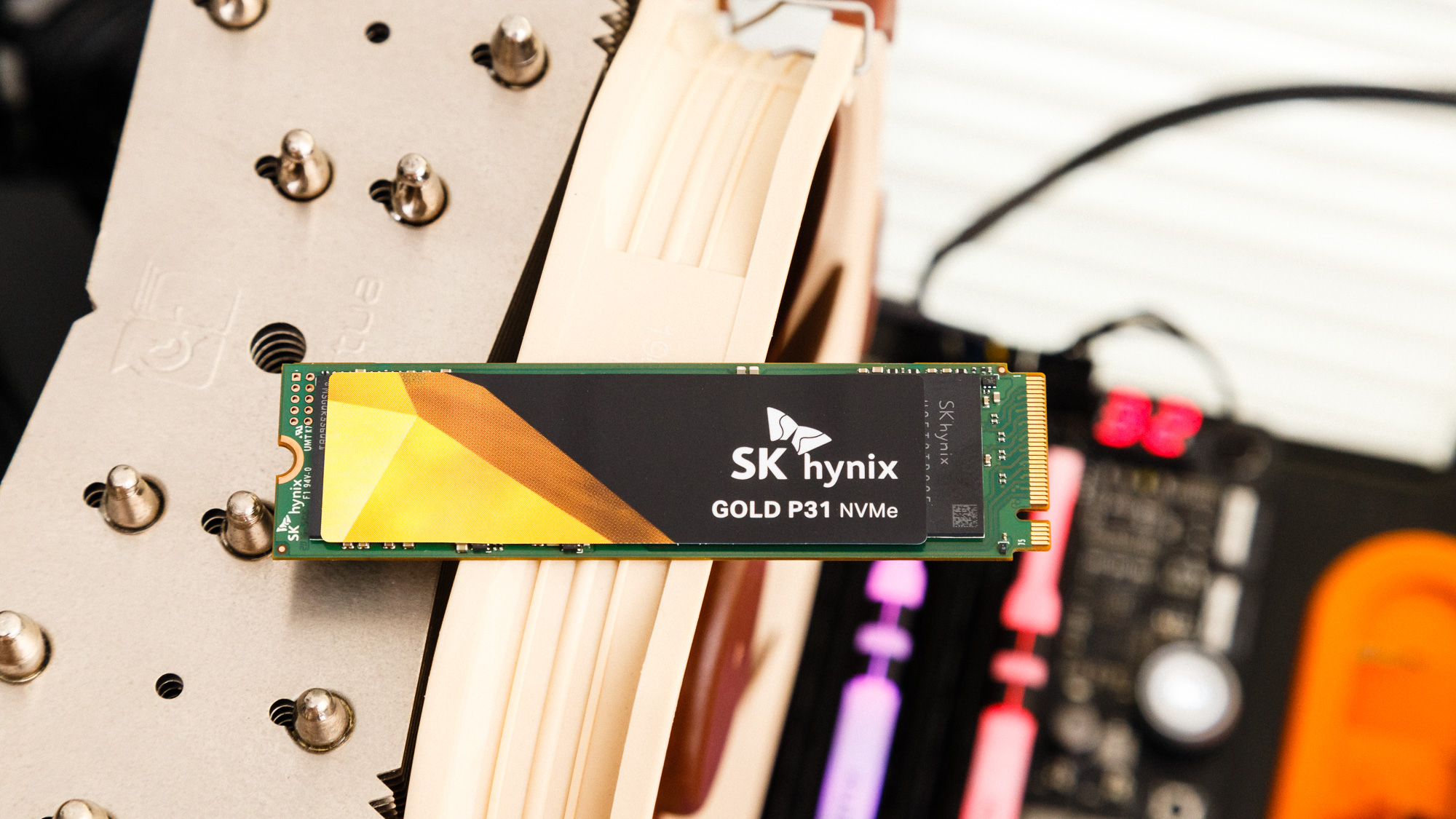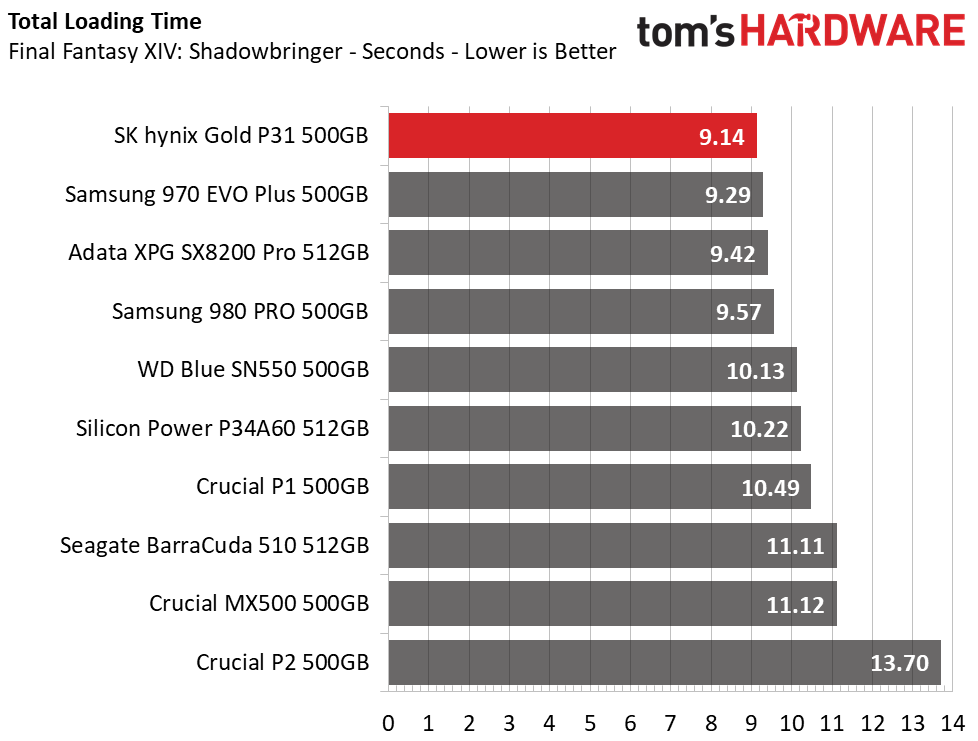Why you can trust Tom's Hardware
SK hynix Gold P31 (500GB)
RATING: ★★★★ ½
PROS
+ Class-leading power efficiency
+ Top-tier performance
+ Competitive endurance & 5-year warranty
+ Single sided-form factor
+ Low cost
CONS
- Lacks AES 256-bit encryption
- Green PCB
- Lacks SSD toolbox
OUR VERDICT
SK hynix's Gold P31 500GB is a top-tier SSD that offers tremendous value. With a powerful and power-efficient design, the Gold P31 competes with the best, but it won’t cost you an arm and a leg.
Get Tom's Hardware's best news and in-depth reviews, straight to your inbox.
Comparison Products
To see just how well the 500GB SK hynix Gold P31 stacks up, we put it up against some of the best SSDs of its class in the market, as well as some cheaper alternatives. Representing the high-end and the Gold P31’s top competition, we included Samsung’s 970 EVO Plus. We also included the Adata SX8200 Pro and Seagate BarraCuda 510. Additionally, we included the WD Blue SN550, Crucial P1, P2, and Silicon Power’s P34A60 as entry-level contenders, as well as a SATA Crucial MX500 for good measure.
Game Scene Loading - Final Fantasy XIV
Final Fantasy XIV Stormbringer is a free real-world game benchmark that easily and accurately compares game load times without the inaccuracy of using a stopwatch.
SK hynix's Gold P31 scores top marks in our game scene loading benchmark. Throughout five levels, the SK hynix averaged the fastest load performance, beating not only the Adata XPG SX8200 Pro and Samsung 970 EVO Plus, but also the 980 Pro. The drive only outperformed the M500 by two seconds overall, so it isn't much faster than even a plain SATA SSD, though.
Transfer Rates – DiskBench
We use the DiskBench storage benchmarking tool to test file transfer performance with our own custom blocks of data. Our 50GB data set includes 31,227 files of various types, like pictures, PDFs, and videos. Our 100GB includes 22,579 files with 50GB of them being large movies. We copy the data sets to new folders and then follow-up with a reading test of a newly written 6.5GB zip file and 15GB movie file.
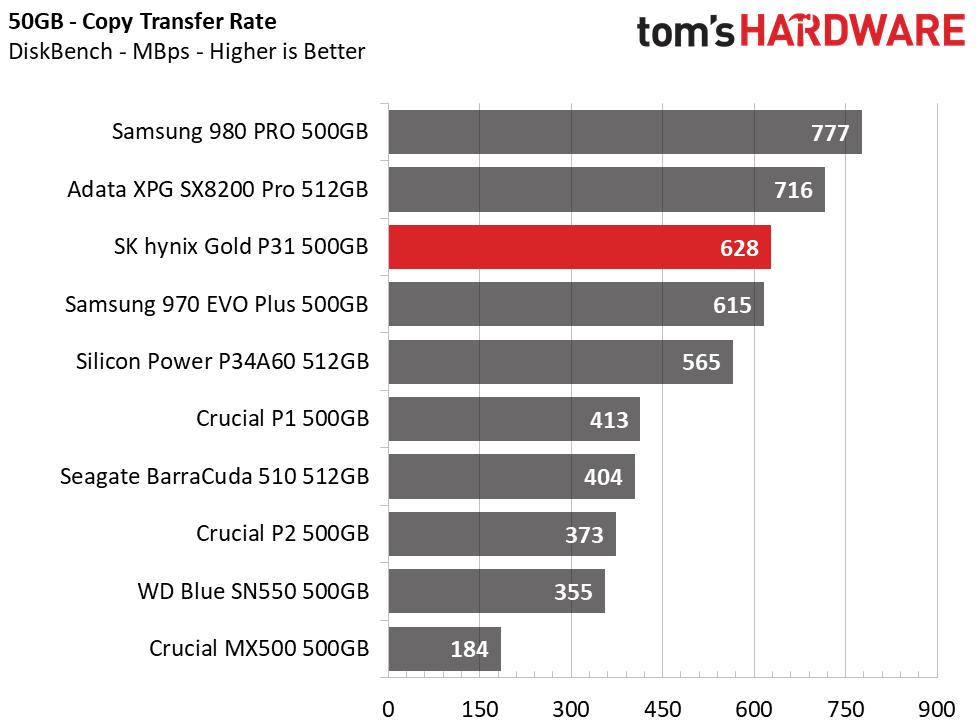
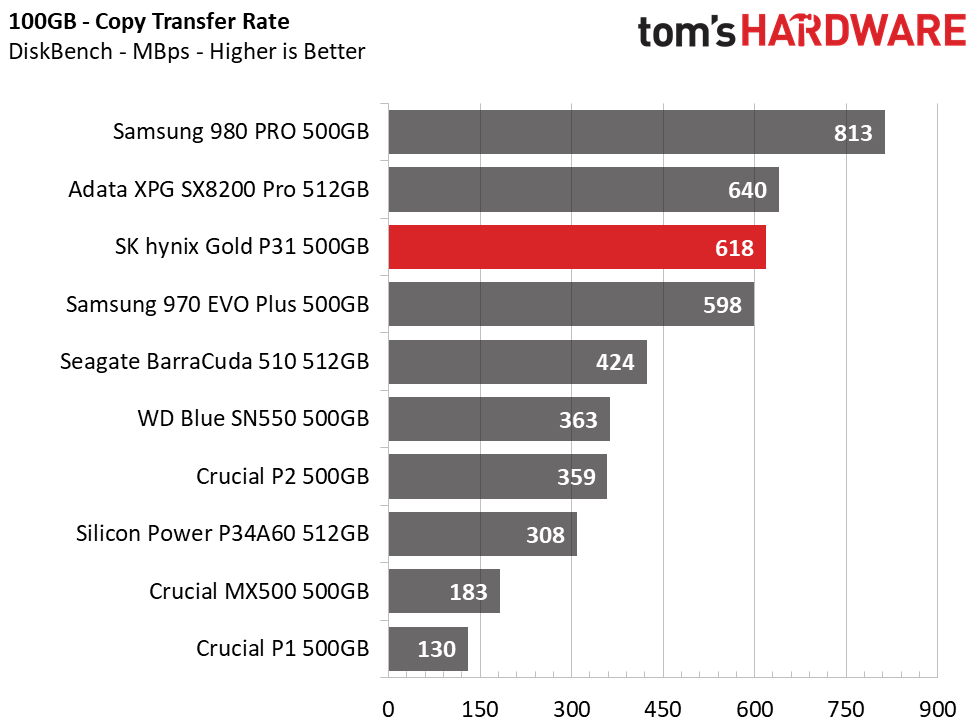
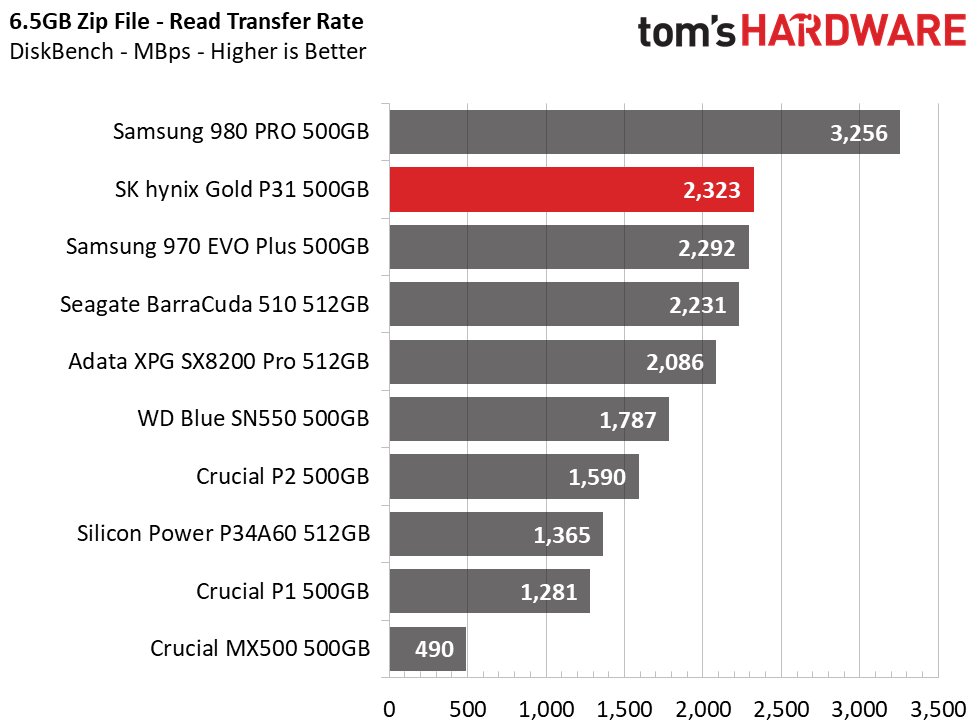
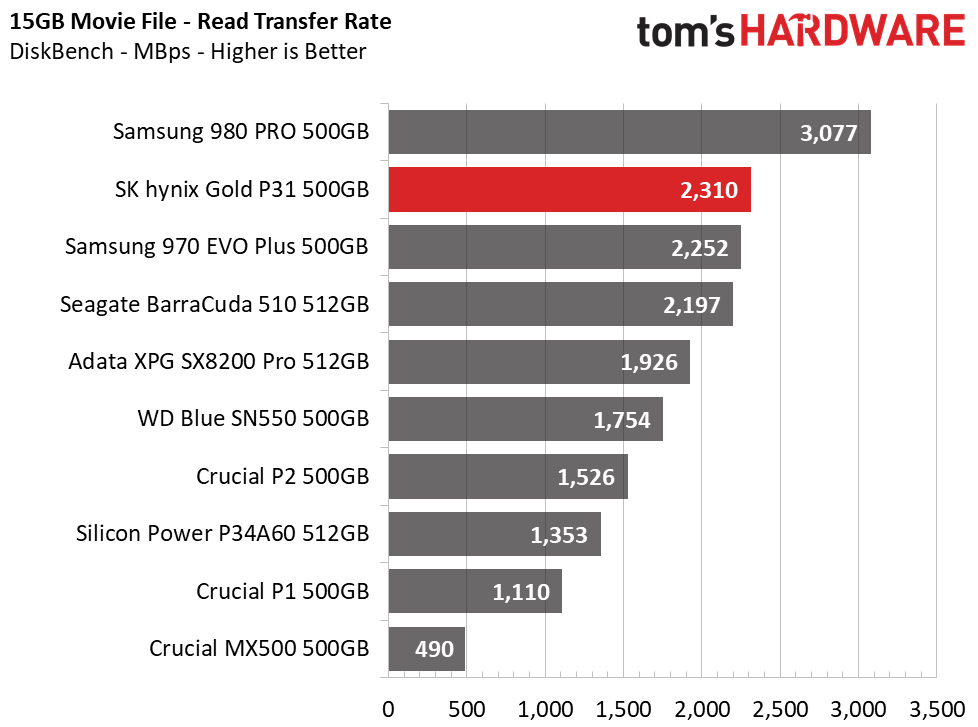
While Adata's XPG SX8200 Pro and Samsung's 980 Pro can move files around faster, SK hynix's Gold P31 still delivers very responsive performance. Scoring third place, it managed to copy both the 50GB and 100GB datasets faster than the Samsung 970 EVO Plus. It also left the QLC Crucial P1 and SATA MX500 in the dust.
Trace Testing – PCMark 10 Storage Tests
PCMark 10 is a trace-based benchmark that uses a wide-ranging set of real-world traces from popular applications and common tasks to measure storage devices' performance. The quick benchmark is more relatable to those who use their PCs for leisure or basic office work, while the full benchmark relates more to power users.
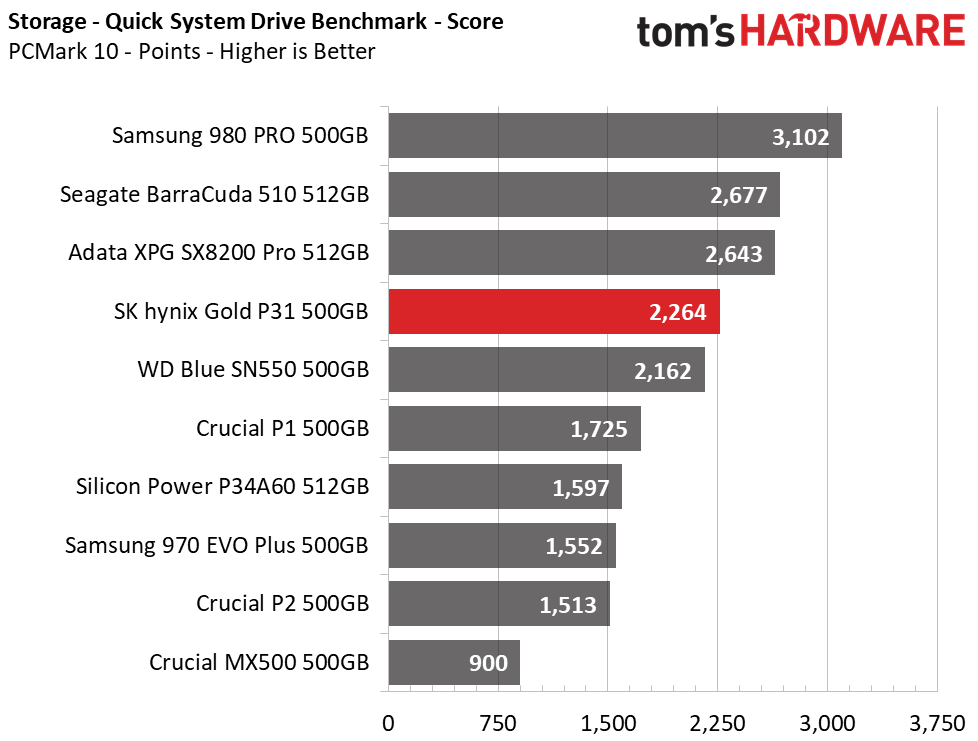
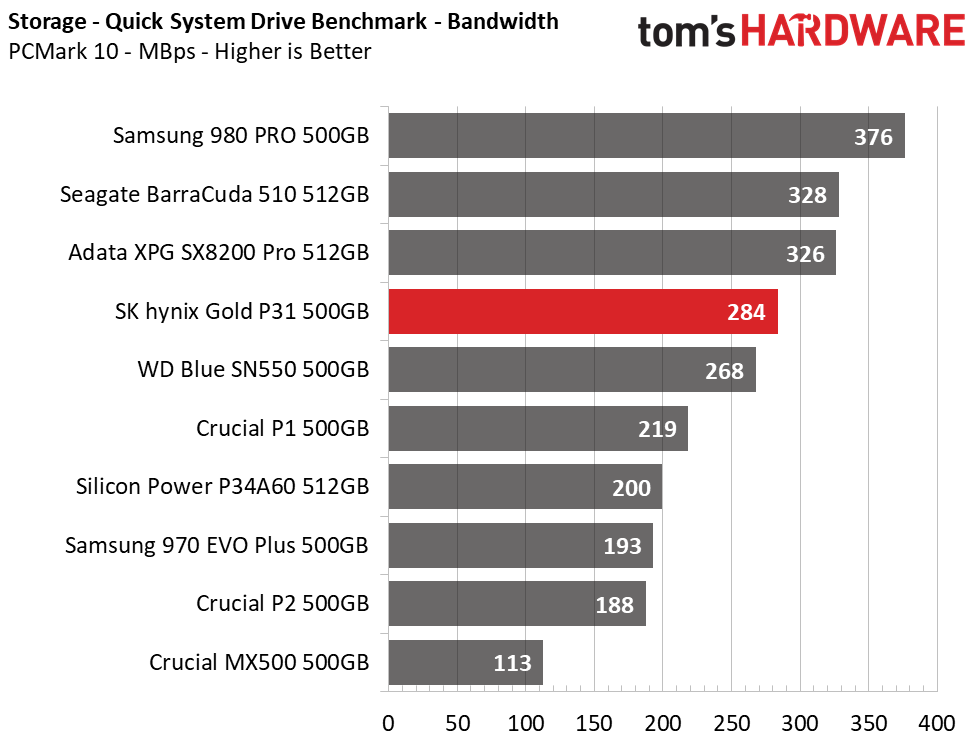
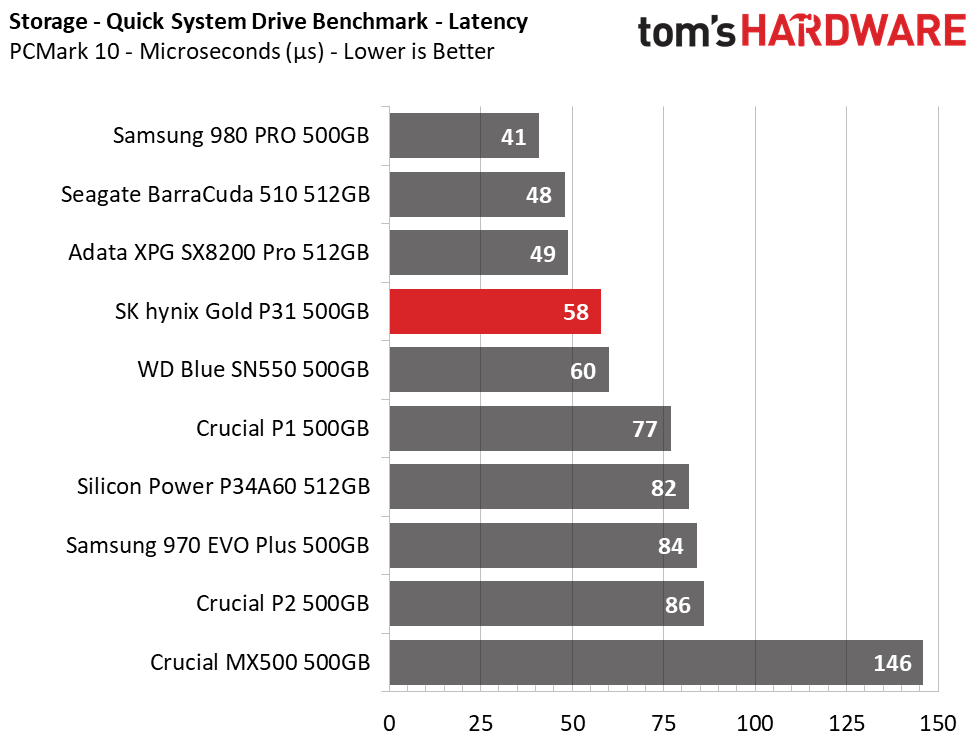
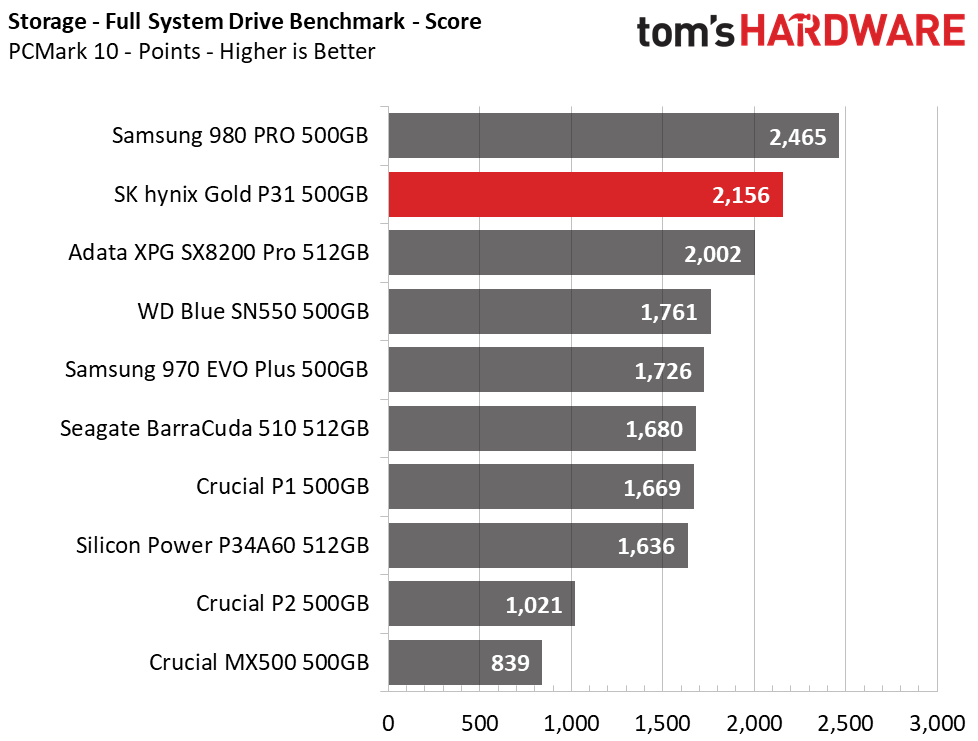

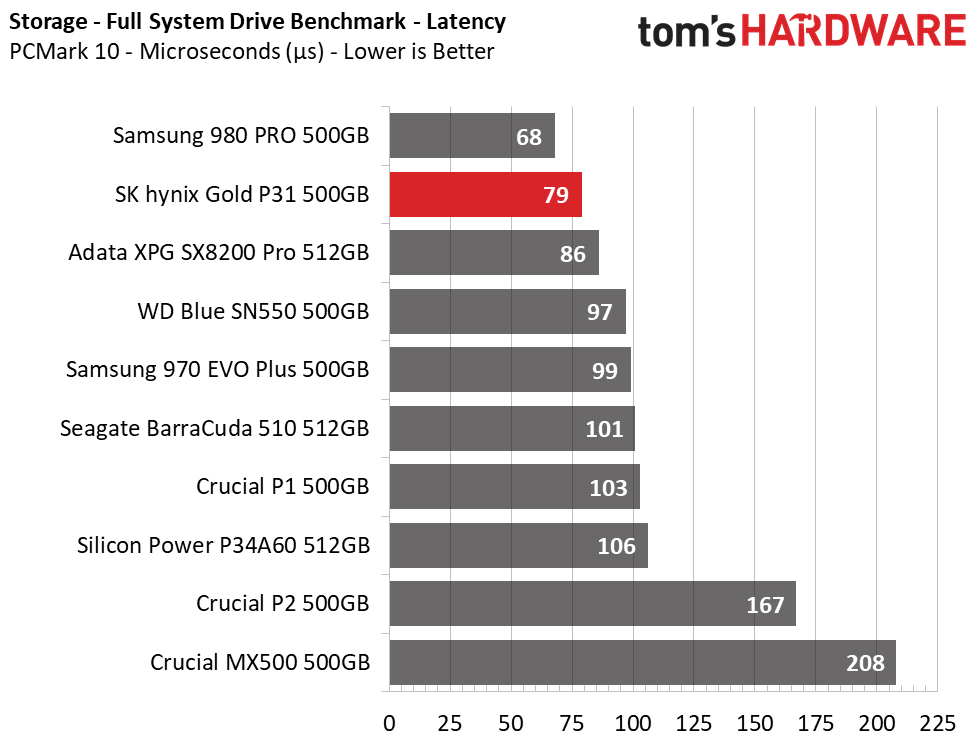
The SK hynix Gold P31 scores well in the quick test, but both the Adata and Seagate provided snappier performance. Once we threw the full drive benchmark its way, SK hynix’s Gold P31 attained the second-highest result we’ve seen from a 500GB NVMe SSD. Both of these tests also demonstrate that NVMe SSDs respond roughly 2-3x faster to requests than SATA counterparts.
Trace Testing – SPECworkstation 3
Like PCMark 10, SPECworkstation 3 is a trace-based benchmark, but it is designed to push the system harder by measuring workstation performance in professional applications.
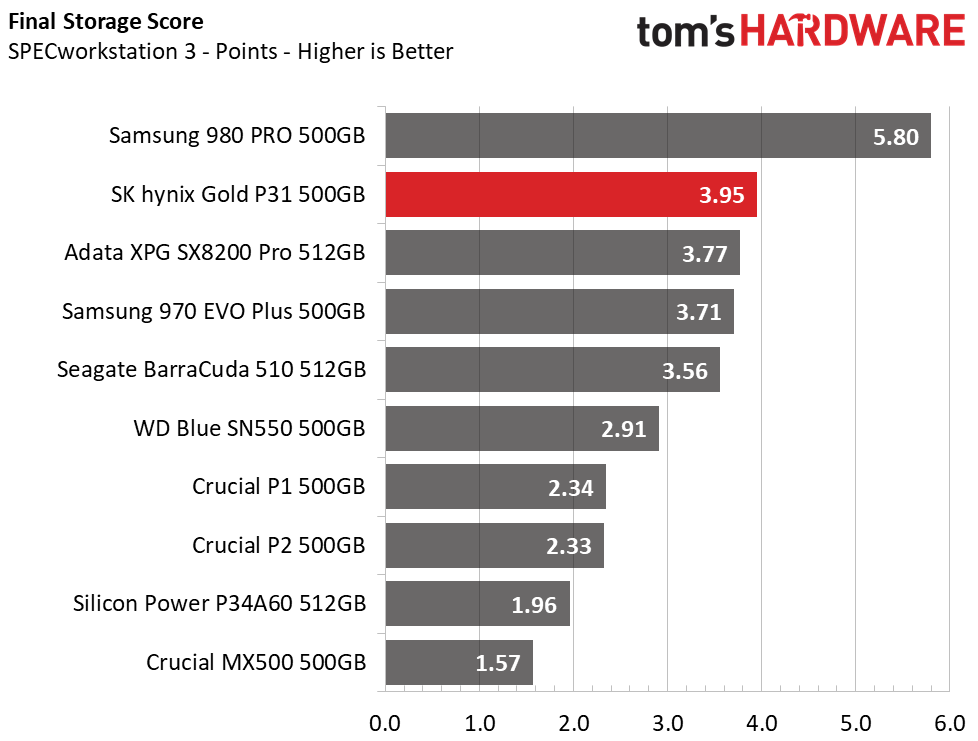
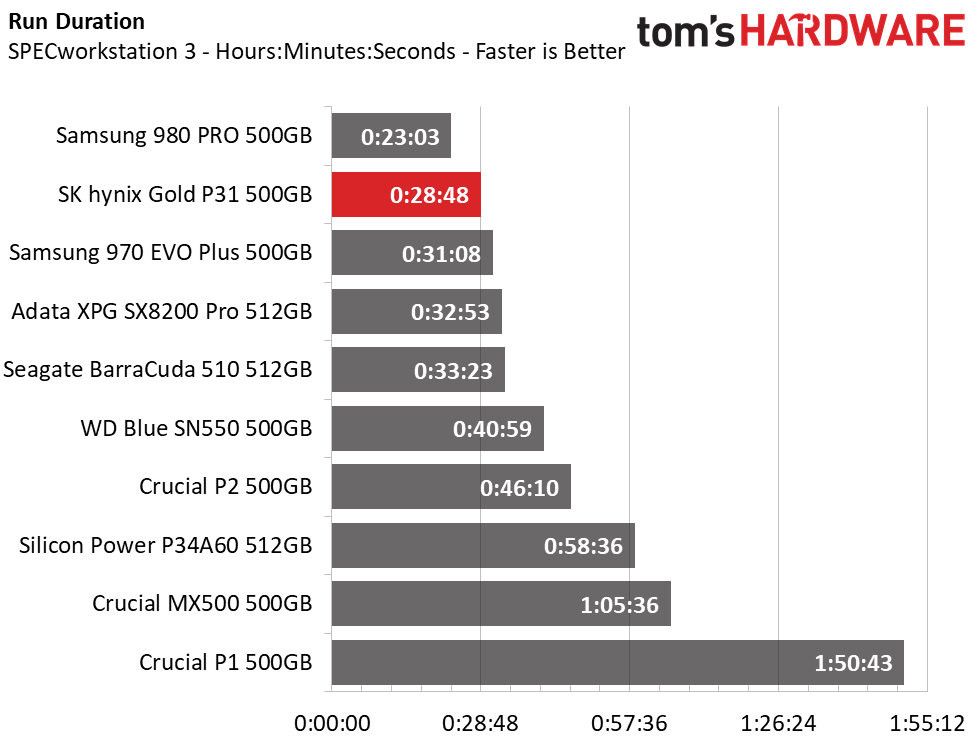
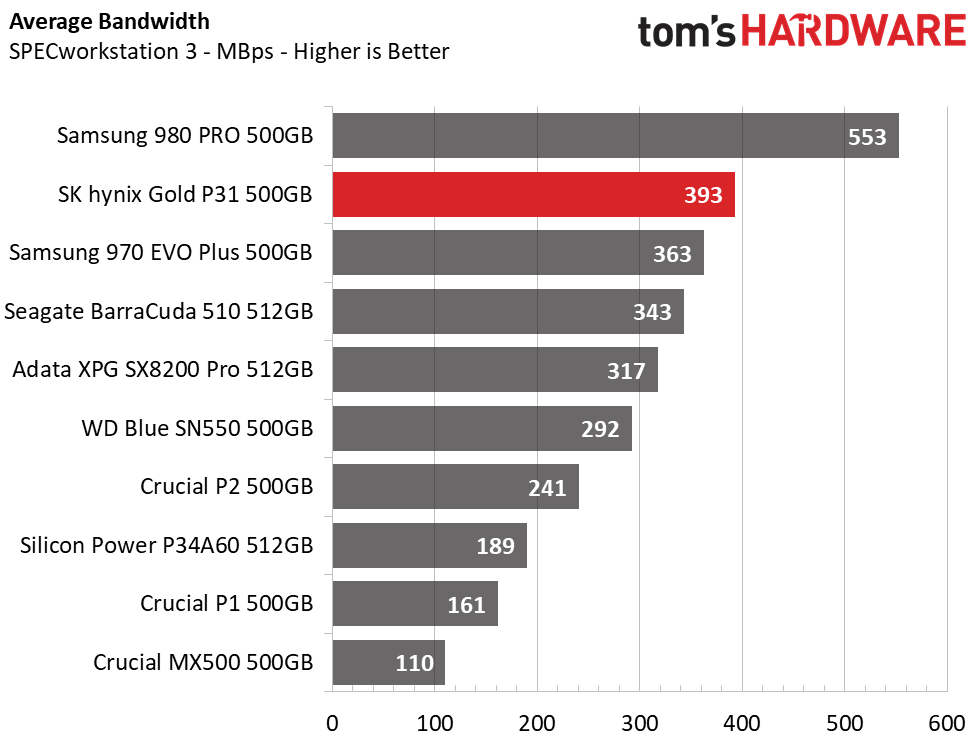
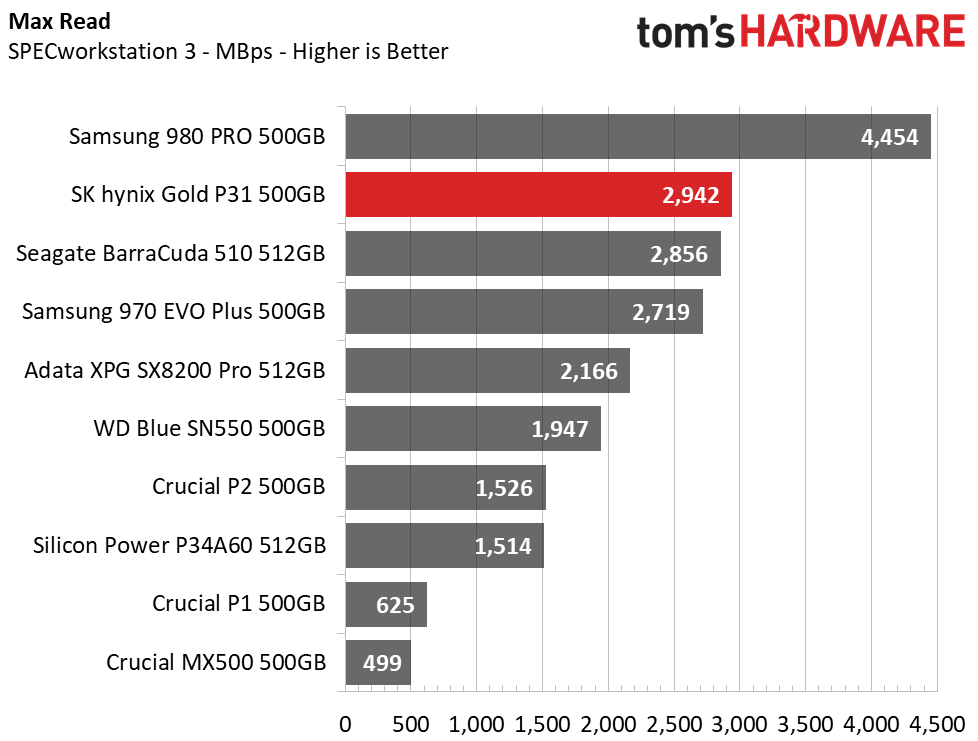
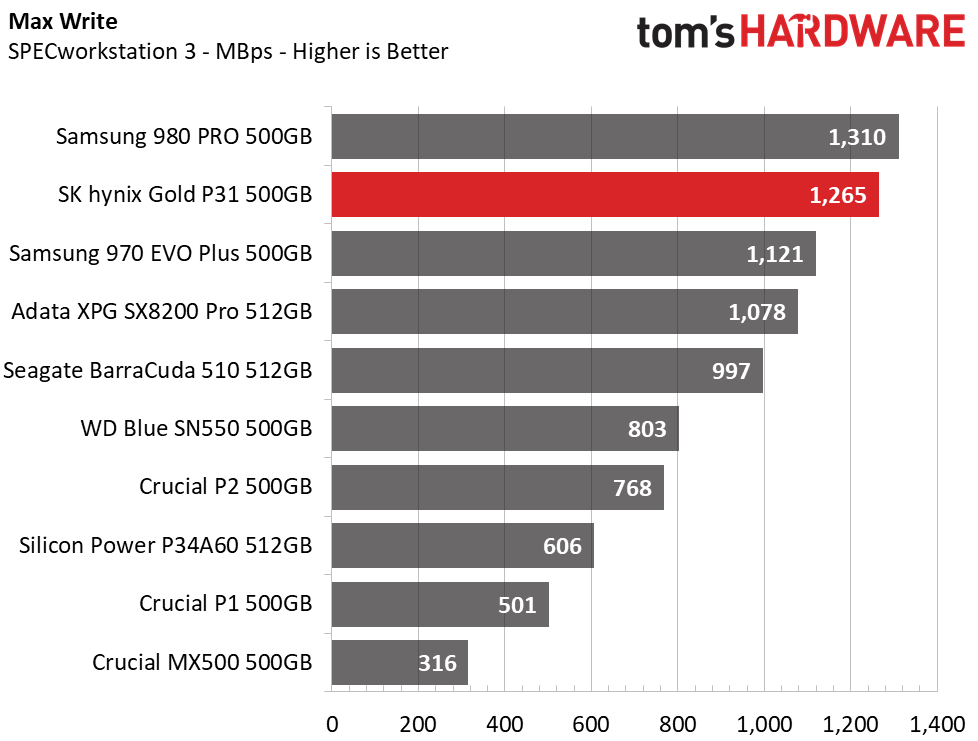
In keeping with what we've seen during the Gold P31's testing thus far, the SSD tears through the prosumer workloads in the SPECworkstation 3 storage benchmark. Other than Samsung's flagship 980 Pro, no other competitor can compare to the speed at which the SK hynix Gold P31 can respond. Again, this is with just only a four-channel controller, indicating this is a well-executed, cost-effective design without the drawbacks of QLC flash.
Synthetic Testing - ATTO / iometer
iometer is an advanced and highly configurable storage benchmarking tool while ATTO is a simple and free application that SSD vendors commonly use to assign sequential performance specifications to their products. Both of these tools give us insight into how the device handles different file sizes.
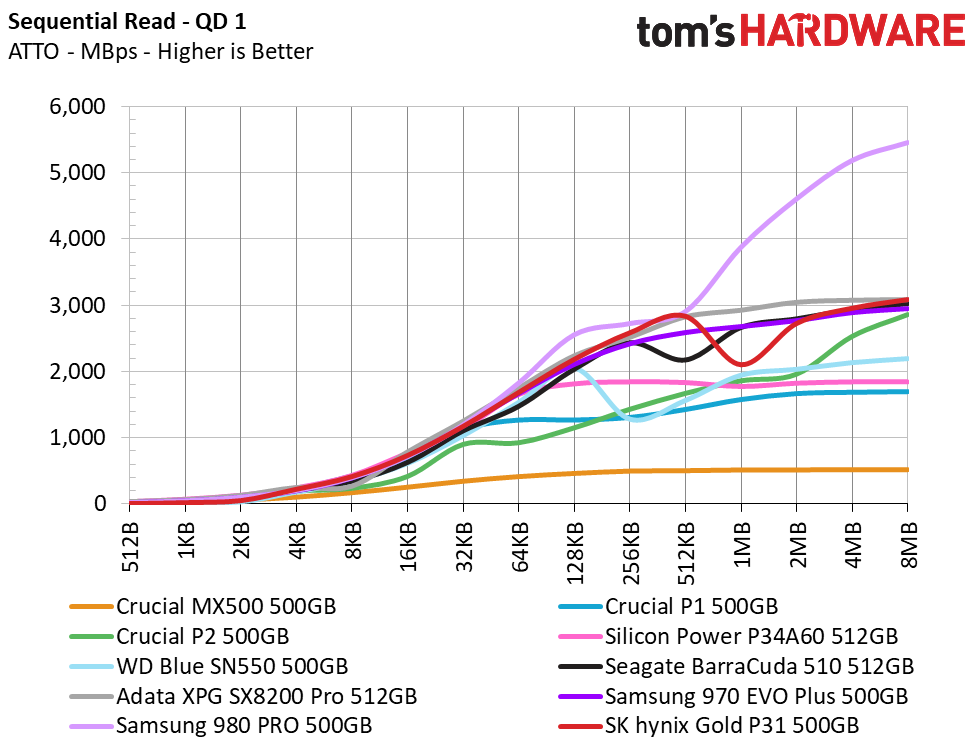
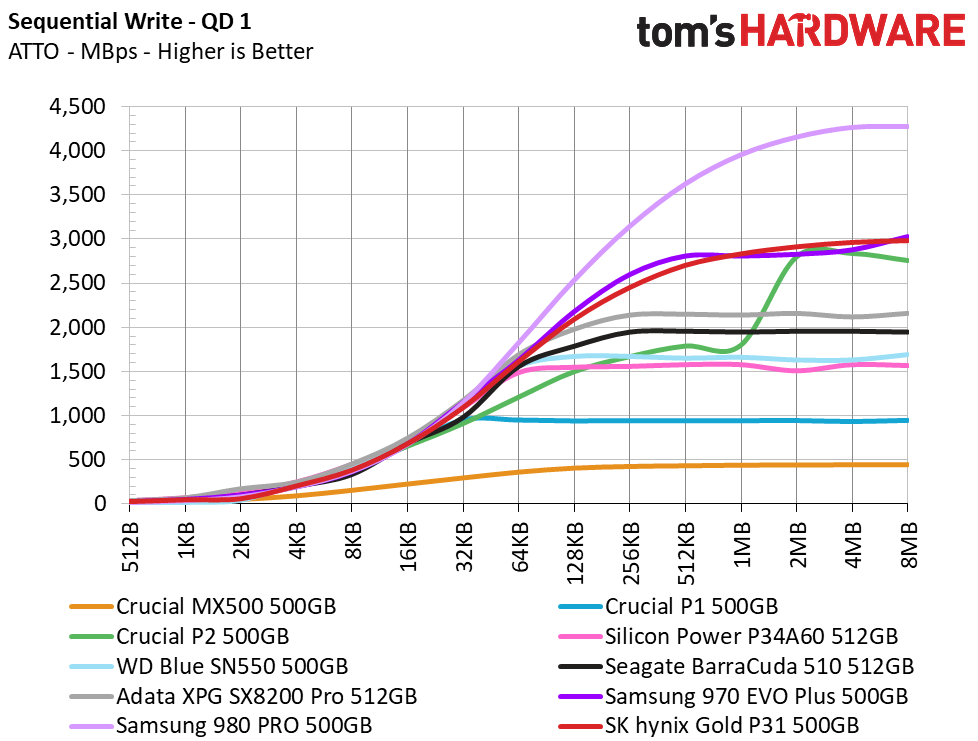
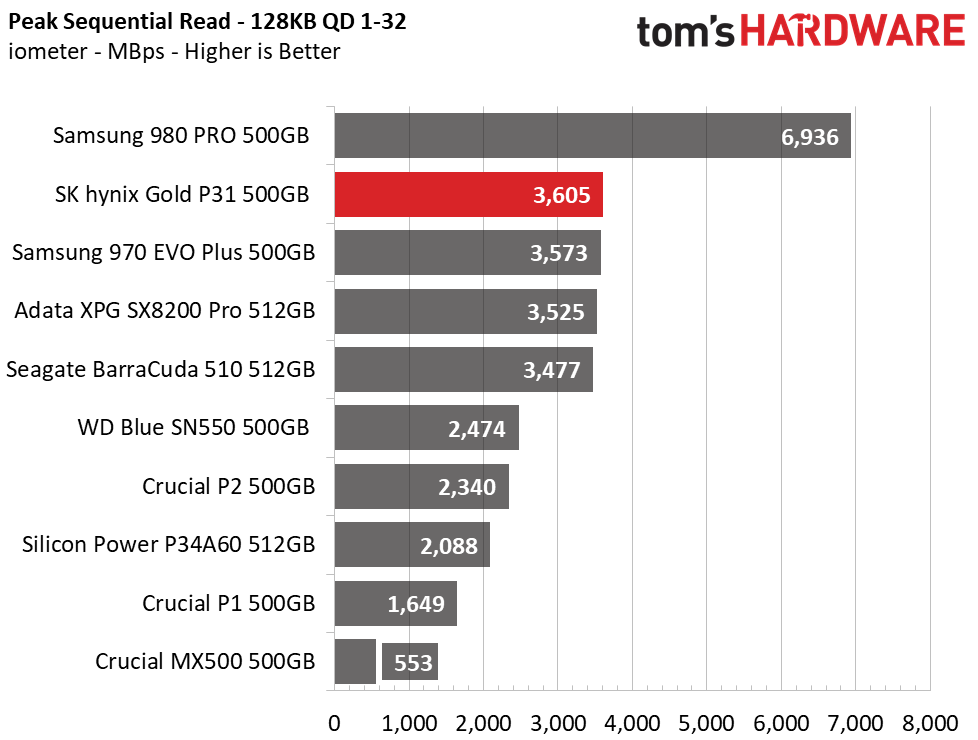
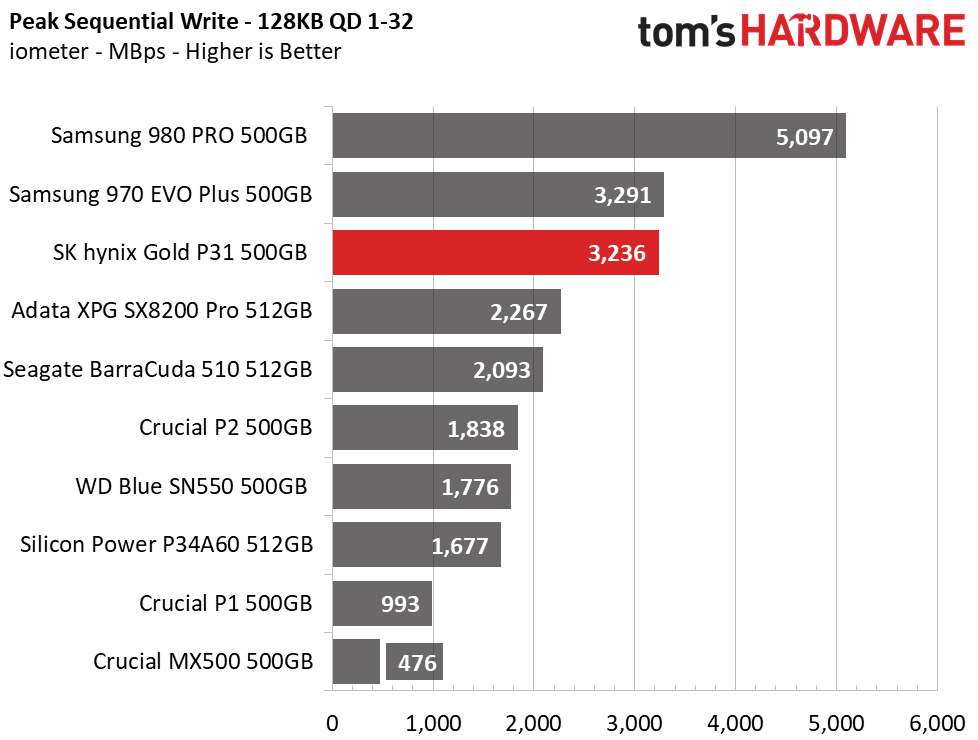
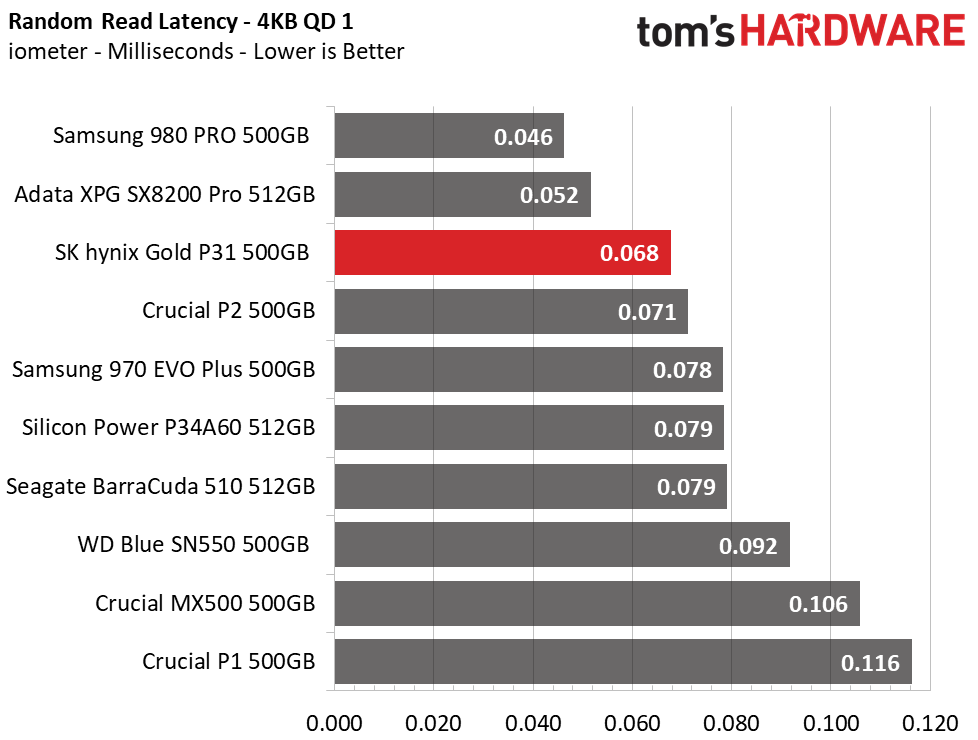
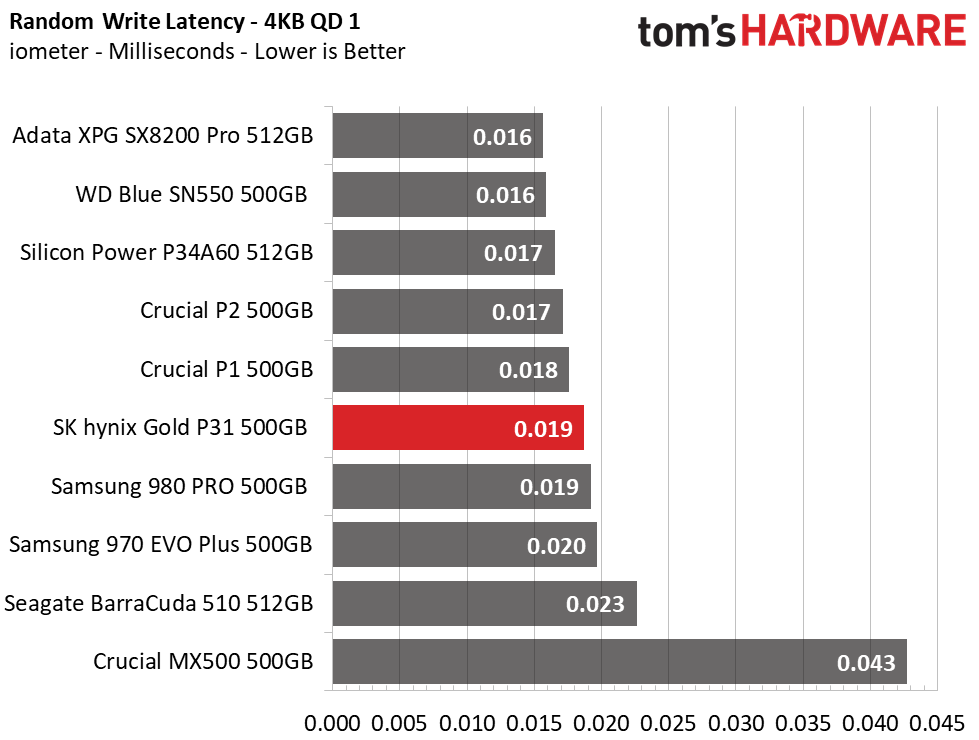
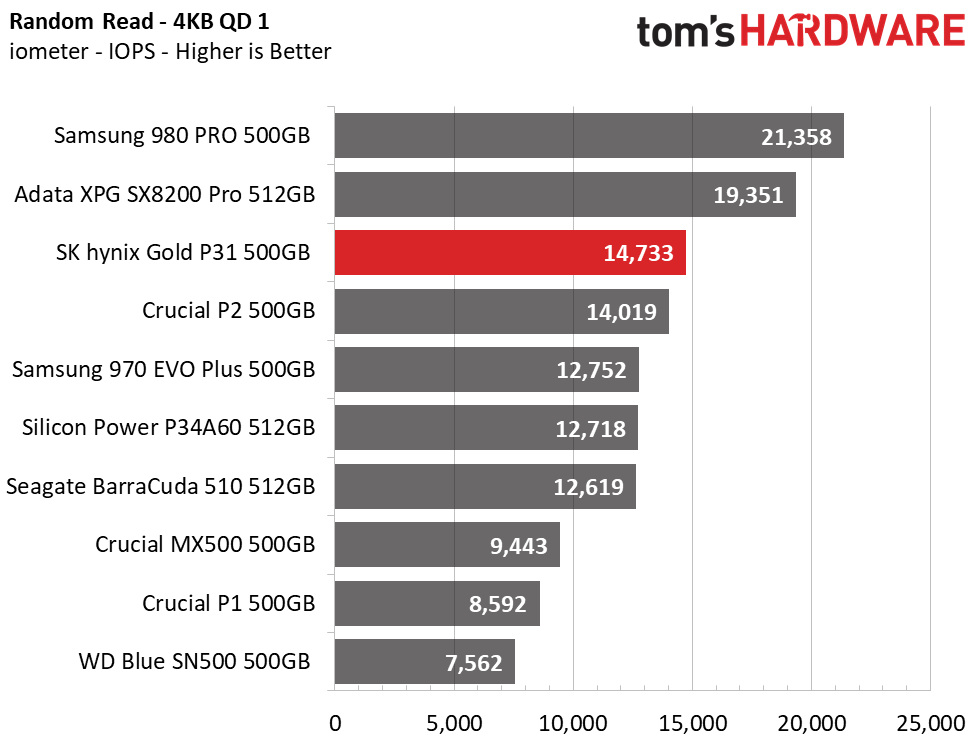
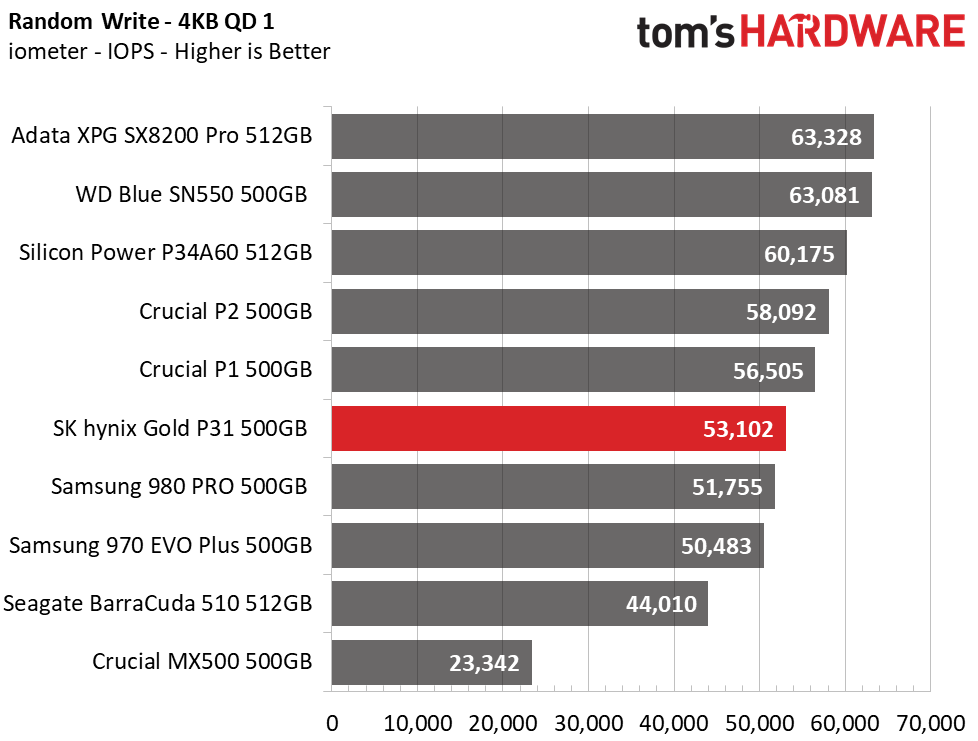
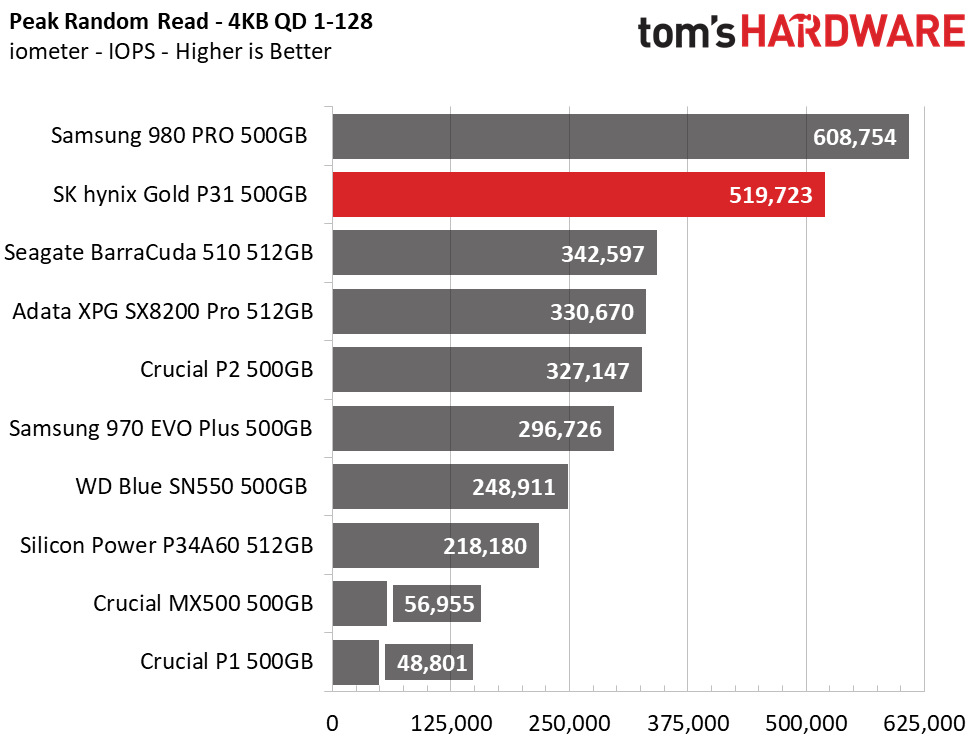
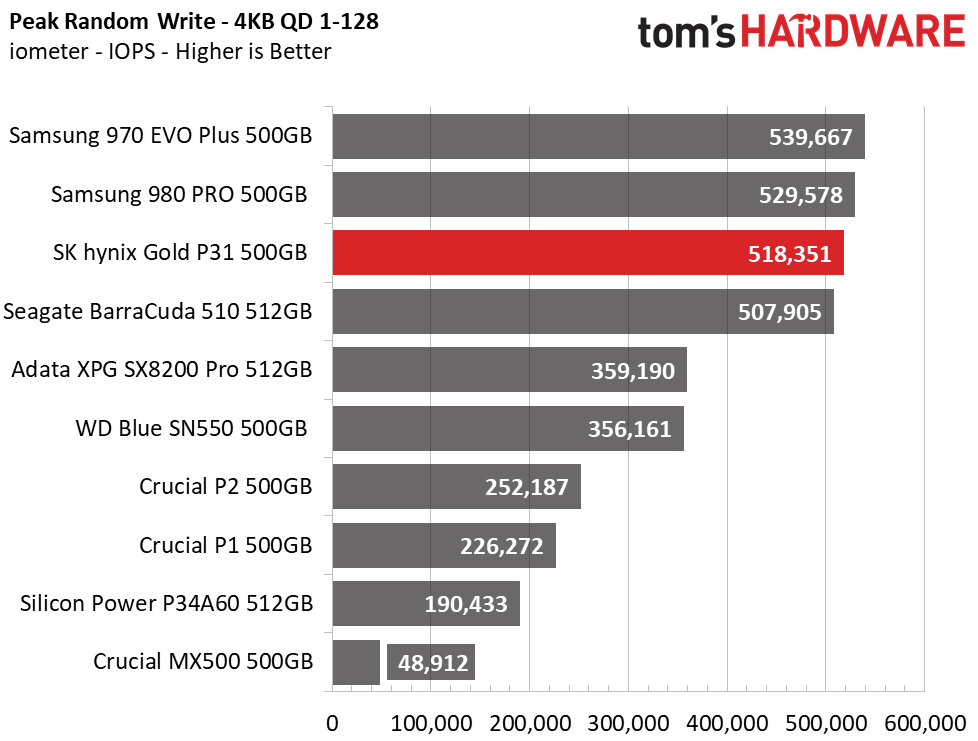
We tested the SK hynix Gold P31 at a QD (queue depth) of 1, representing most day-to-day file access at various block sizes, as well as a few higher QDs at 128K and 1MB. At a QD of 1, the drive is comparable to many of the most responsive eight-channel SSDs on the market. We measured peak throughput at roughly 3.6/3.2 GBps.
The Gold P31 also responds to random requests faster than most drives, though it trails the Adata SXPG SX8200 Pro and the Samsung 980 Pro. The Gold P31 also delivered exceptionally strong peak random read/write IOPS when hammered with over a hundred concurrent requests, which is especially impressive given the simplified design.
Sustained Write Performance and Cache Recover
Official write specifications are only part of the performance picture. Most SSDs implement a write cache, which is a fast area of (usually) pseudo-SLC programmed flash that absorbs incoming data. Sustained write speeds can suffer tremendously once the workload spills outside of the cache and into the "native" TLC or QLC flash. We use iometer to hammer the SSD with sequential writes for 15 minutes to measure both the size of the write cache and performance after the cache is saturated. We also monitor cache recovery via multiple idle rounds.
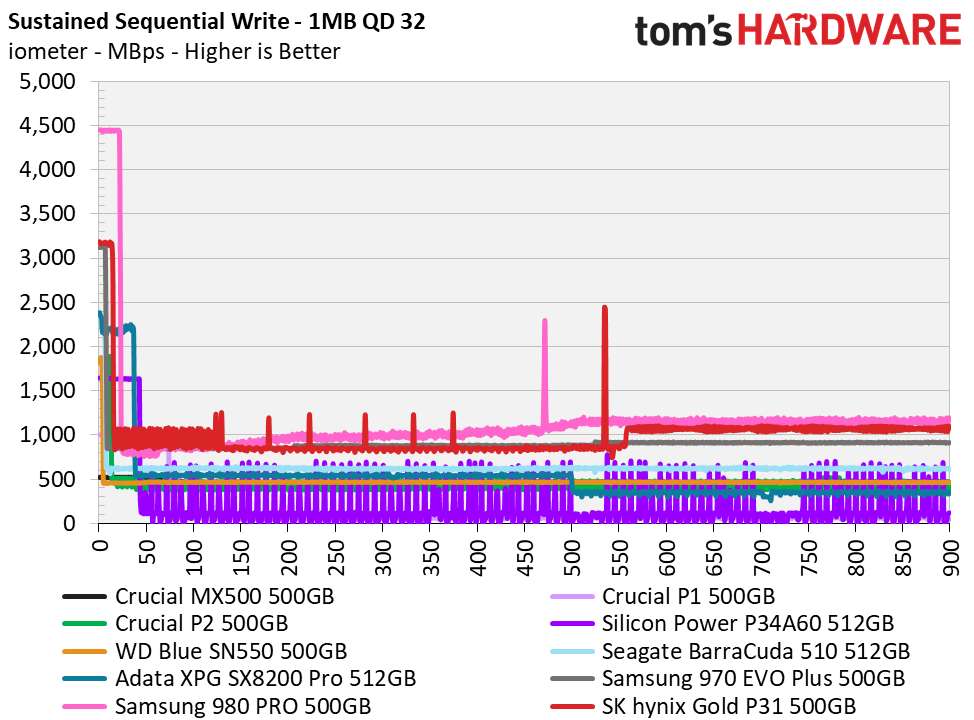
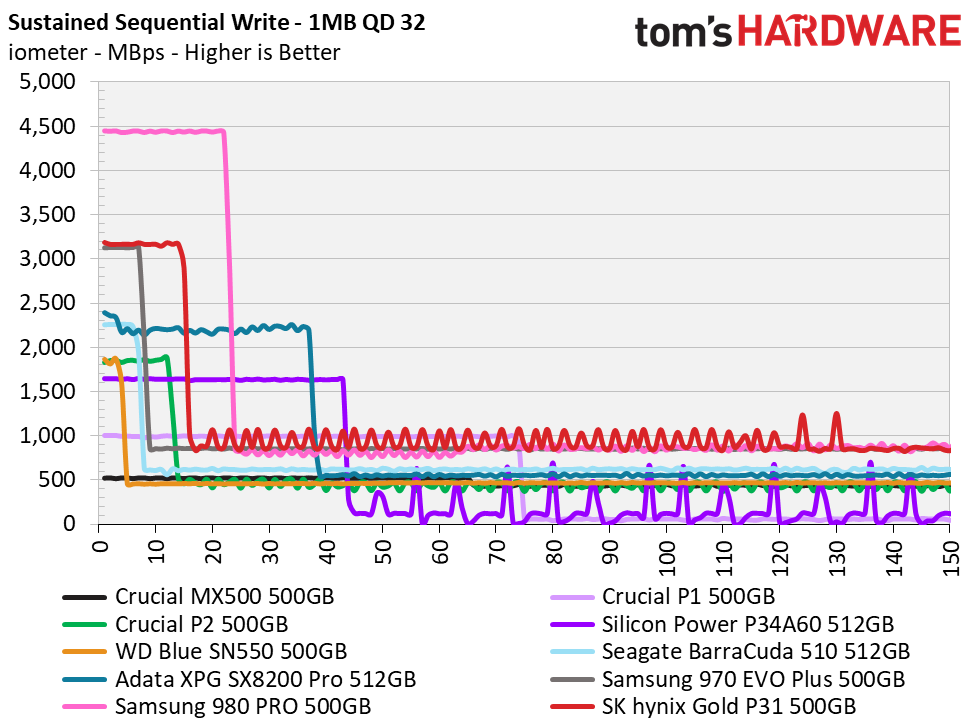
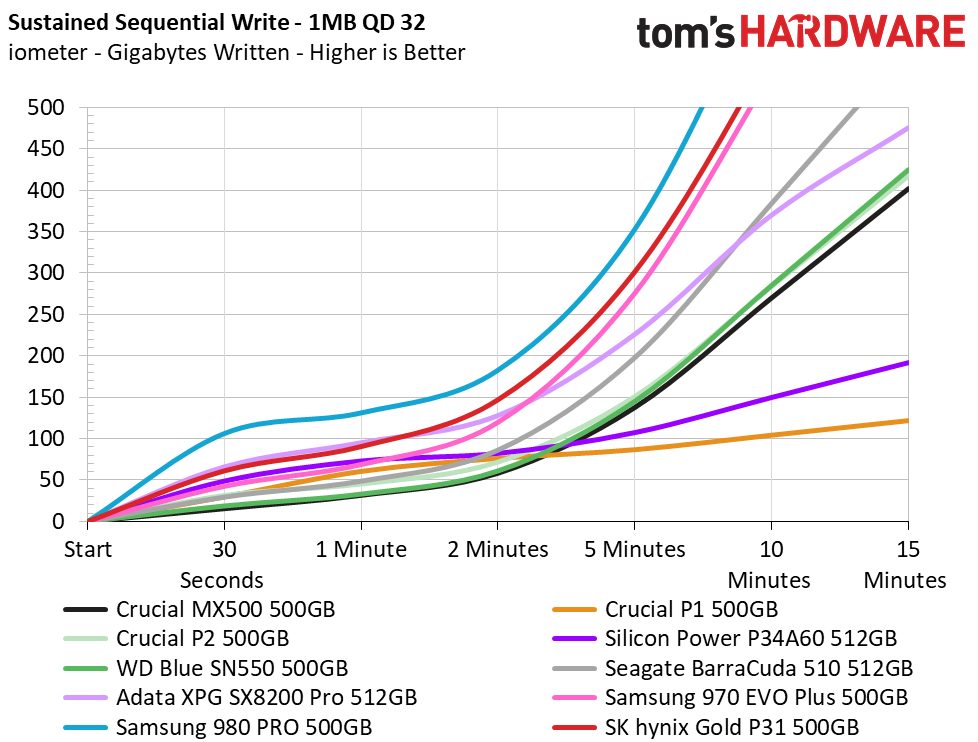
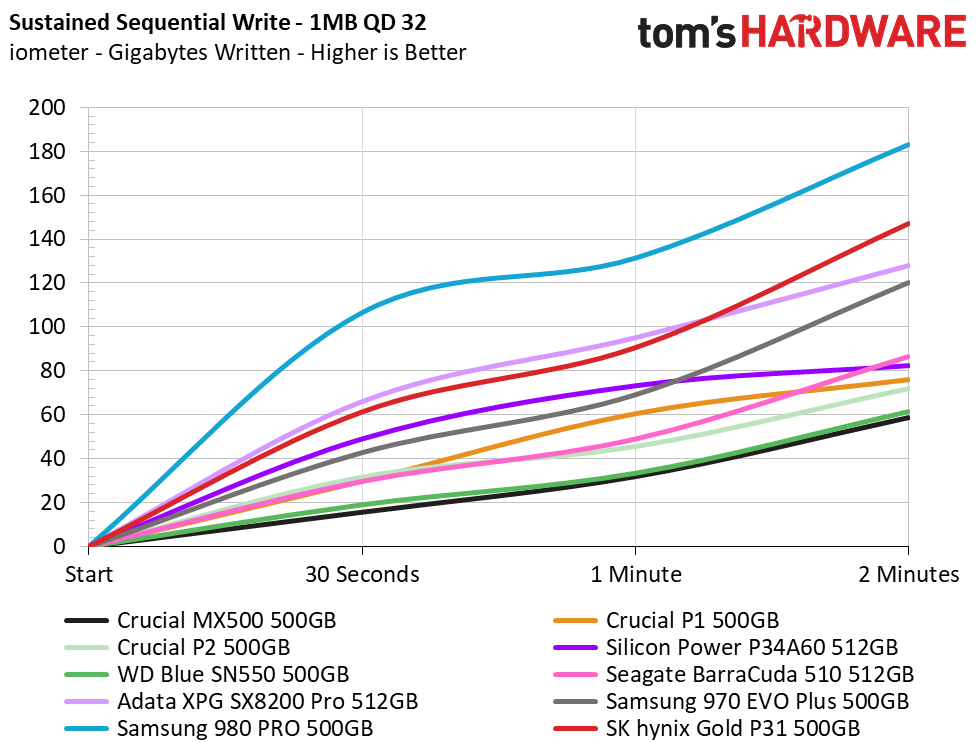
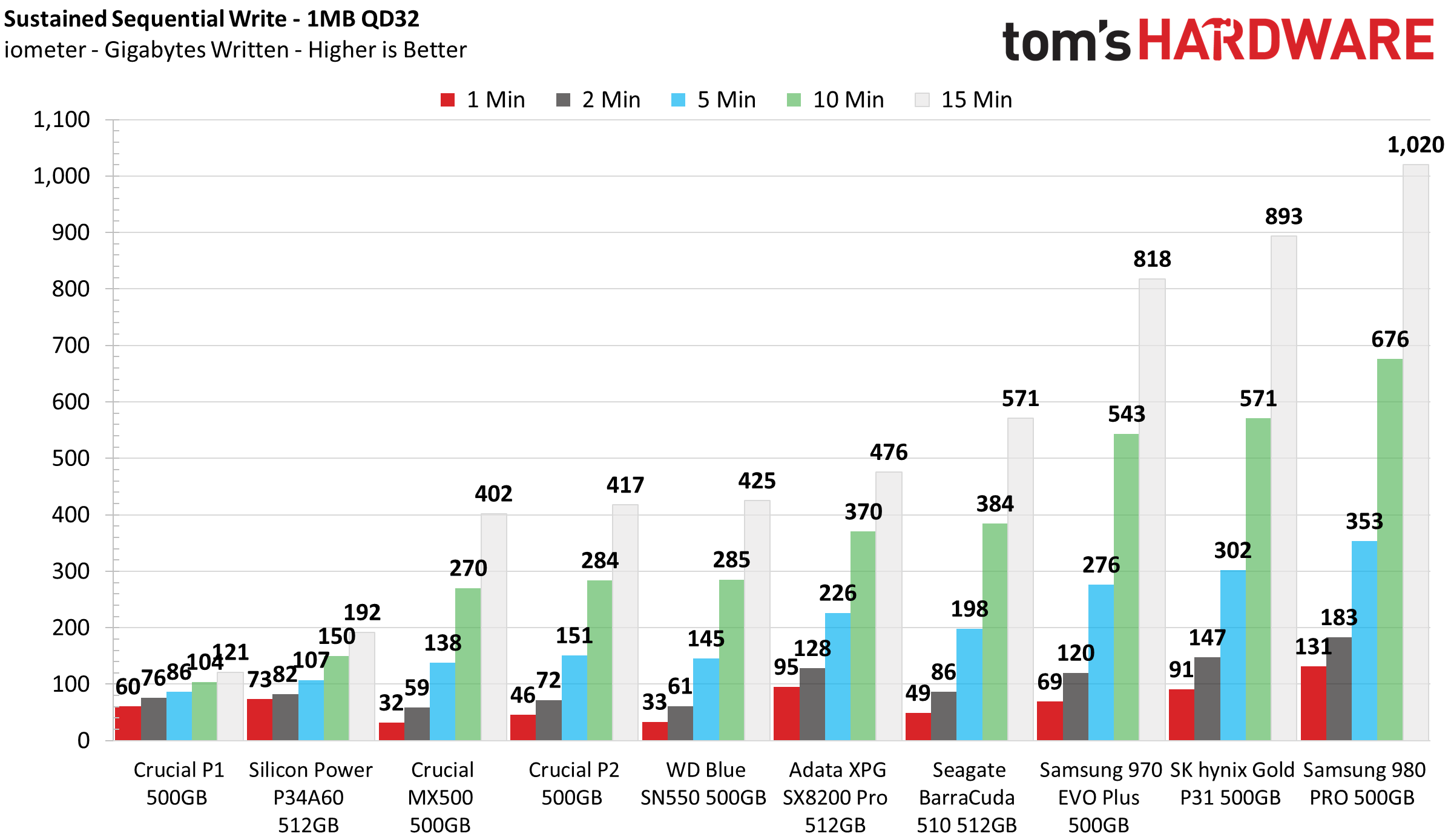
The PCIe 4.0 x4 Samsung 980 Pro is much faster if you have a supporting system, but the Gold P31 holds its own well in terms of its write capability. The Gold P31's large SLC cache achieves stellar write performance that puts even the 970 EVO Plus to shame. After writing at a rate of 3.2 GBps for the first 48GB of the test, the Gold P31 degraded to an average speed of 900 MBps until the drive was full. Given some idle time to recover, the SSD only recovered 4GB of its SLC cache within 30 minutes.
Power Consumption and Temperature
We use the Quarch HD Programmable Power Module to gain a deeper understanding of power characteristics. Idle power consumption is an important aspect to consider, especially if you're looking for a laptop upgrade. Some SSDs can consume watts of power at idle while better-suited ones sip just milliwatts. Average workload power consumption and max consumption are two other aspects of power consumption, but performance-per-watt is more important. A drive might consume more power during any given workload, but accomplishing a task faster allows the drive to drop into an idle state faster, which ultimately saves power.
We also monitor the temperature of the drive via the S.M.A.R.T. data and an IR thermometer to see when (or if) thermal throttling kicks in and how it impacts performance. Bear in mind that results will vary based on the workload and ambient air temperature.
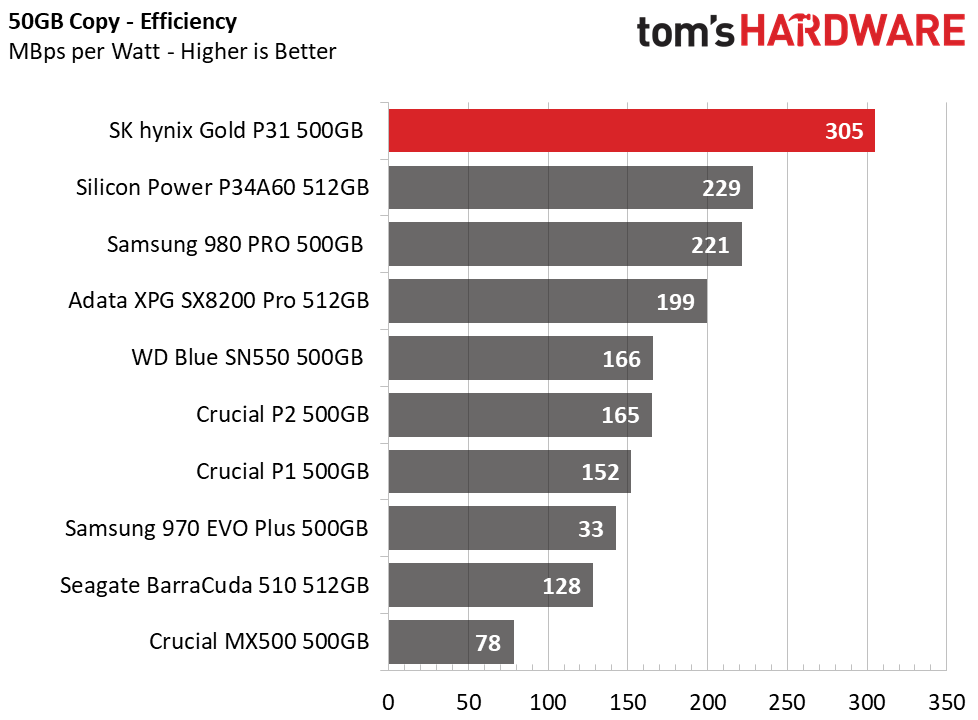
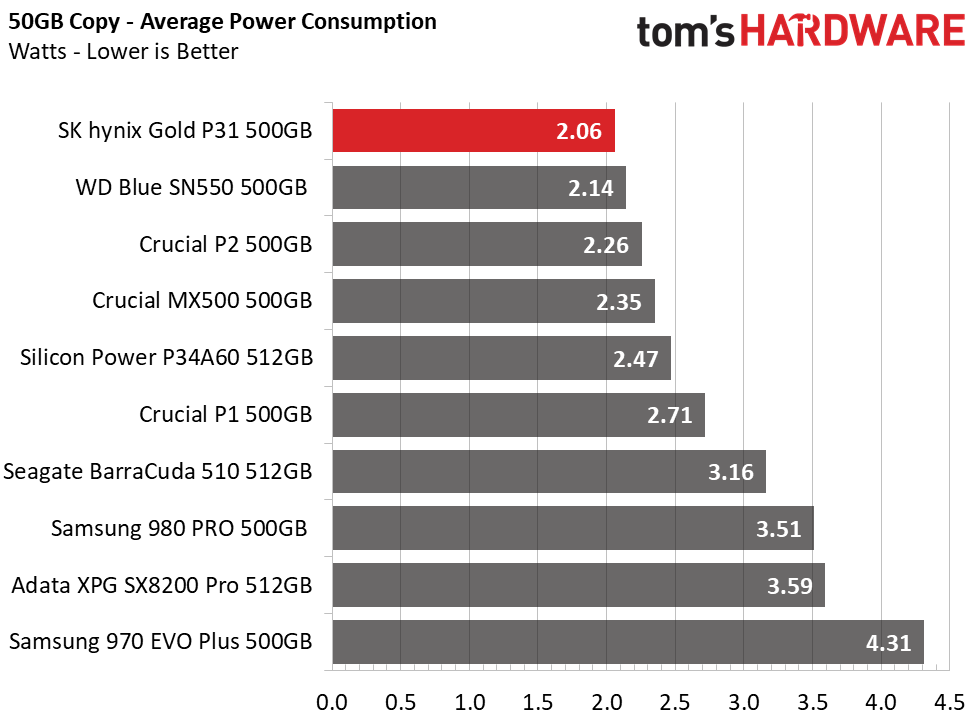
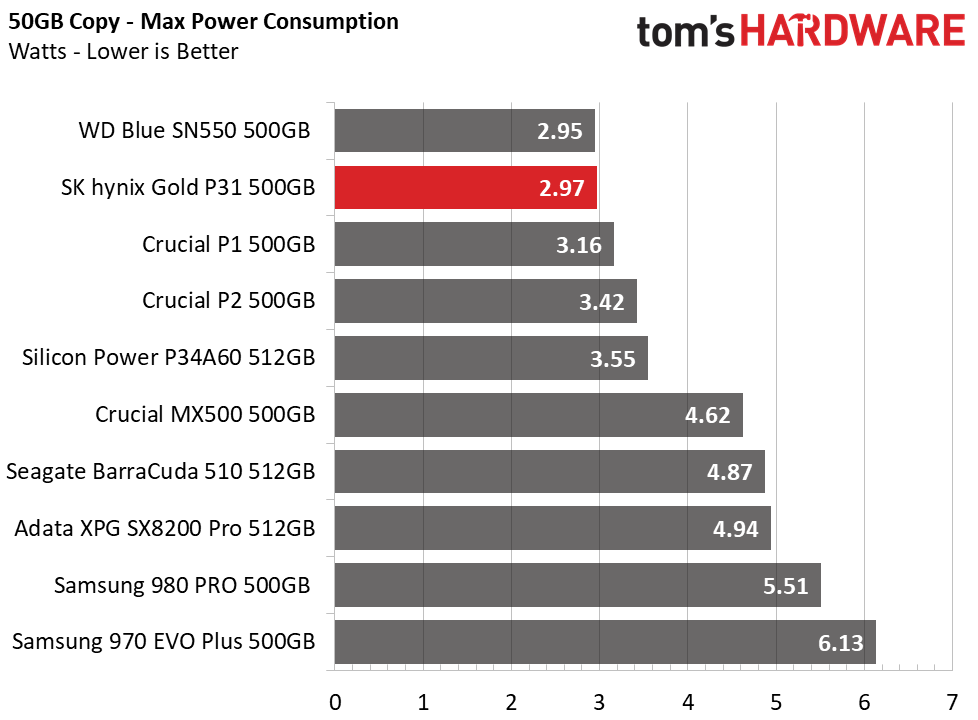
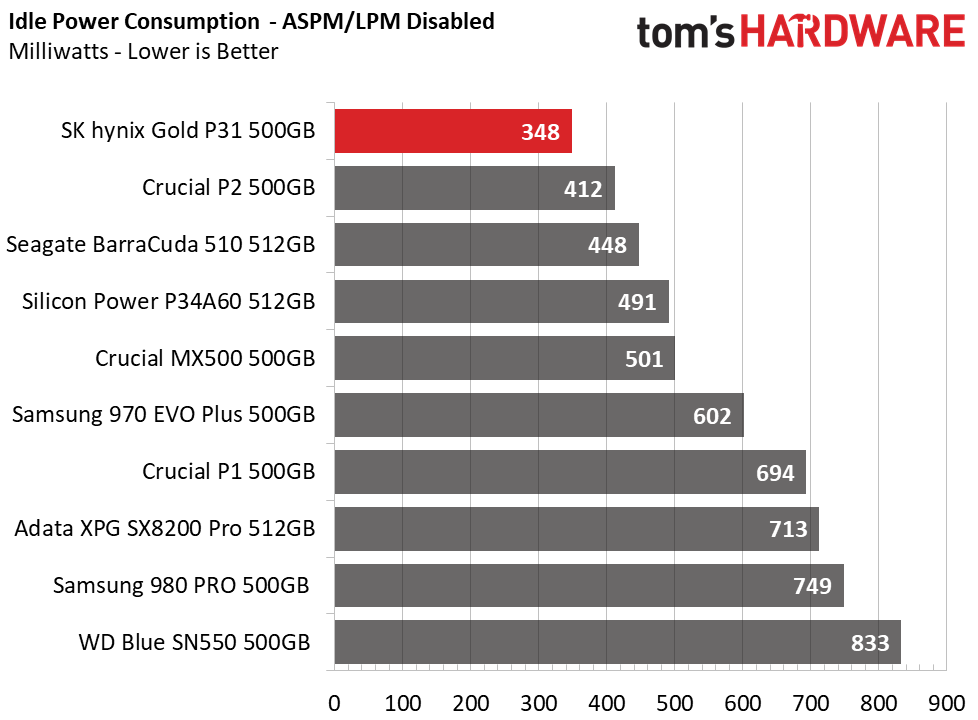
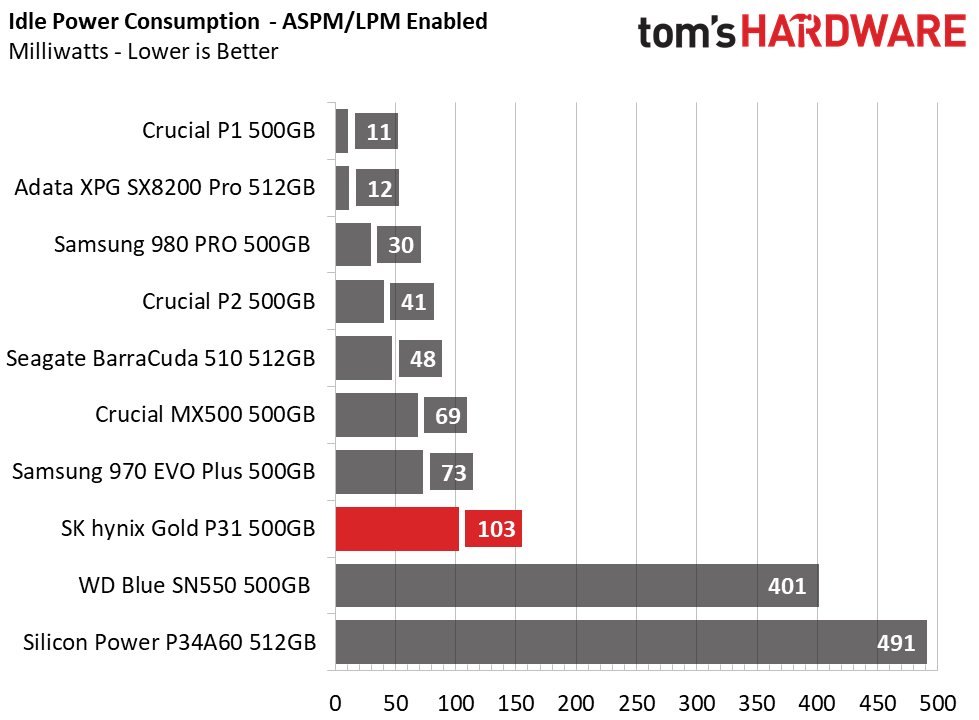
SK hynix’s Gold P31 is very power efficient thanks to its design. Scoring 305 MBps-per-watt, it leads the test pool by a large margin. On average, the Gold P31 sipped roughly two watts and didn’t even surpass 3W under peak load. Idle power consumption is very good when the device is in an active idle state, but higher than average when ASPM is enabled. Additionally, when copying 300GB of data to the SSD, peak temperatures were in the range of 65-70 degrees Celsius, and it never throttled.
MORE: Best SSDs
MORE: How We Test HDDs And SSDs
MORE: All SSD Content
Current page: 500GB Performance Results for SK hynix Gold P31
Prev Page Features and Specifications Next Page 1TB Performance Results for SK hynix Gold P31
Sean is a Contributing Editor at Tom’s Hardware US, covering storage hardware.
-
King_V Some nits to picK pick (because, clearly, I'm more likely to fumble when I'm pointing out someone else's fumbles)Reply
Spec table column headers both say 1TB, the first one should be 500GB (or 512?)
Paragraph below spec table says "though the 500GB model suffers a minimal performance loss with a write speed that is 100MBps lower" but the table shows the 500GB model having a faster sequential write speed. Which one is correct?That aside - I'm definitely intrigued that it's competitive speed-wise, and manages that impressive level of power efficiency. I think this one might be on my list for a future PC. -
seanwebster Thanks, I actually saw that too not too long ago and already alert the team on the errors. The write speeds should be swapped. 3,200 on the 1TB and 3,100 on the 500GB. Correction should go live shortly.Reply -
cknoettg One more possible point of contention.Reply
The article states that the P31 Gold does not support AES-256.
But SK Hynix's own website for the P31 gold states that it does:
https://skhynix.freshdesk.com/support/solutions/folders/48000658600#faq_title
"All SSDs from SK hynix come with the AES 256-bit encryption feature. "
I have seen manufacturer's documentation be wrong, but is there any way to test to see if it does or not? -
seanwebster Reply
Nice find. This wasn't posted nor articulated at the time of publishing. We will update to include this.cknoettg said:One more possible point of contention.
The article states that the P31 Gold does not support AES-256.
But SK Hynix's own website for the P31 gold states that it does:
https://skhynix.freshdesk.com/support/solutions/folders/48000658600#faq_title"All SSDs from SK hynix come with the AES 256-bit encryption feature. "
I have seen manufacturer's documentation be wrong, but is there any way to test to see if it does or not? -
DZIrl And what is benefit for user in using 128 layers SSD? Nothing! Drives even cheaper to produce are not cheaper then any other.Reply
Why then? -
Soaptrail Reply
Thank you.Rogue Leader said:This thread has been reopened due to the article update
Anyone know what changed in the new firmware. I skimmed the article and must have missed it. Also it appears not to affect the 1TB drive since those numbers were not updated. I know the 500GB page was updated but what were the original benchmarks for that drive? -
retrofitit Who cares if it has a green PCB?Reply
I put it in my laptop, put the bottom back on and it is not visible.
The desktop another is going in has no glass panel.
It could have a hot pink PCB or baby poo yellow PCB and I would not care, the efficiency and performance is all that matters. -
retrofitit What I would like to know is are they comparing it to the ADATA SX8200 Pro that was provided as an early reviewer sample or the lower spec version actually being sold retail?Reply
